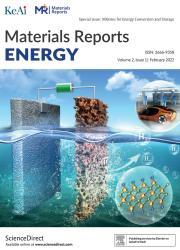Optimized synthesis and electrochemical behaviors of Prussian blue analogues cathodes for potassium-ion batteries
IF 13.8
引用次数: 0
Abstract
The superior adaptability of Prussian blue analogues (PBAs) in interacting with potassium ions has shifted research focus toward their potential application as cathodes of potassium-ion batteries (PIBs). The large interstitial space formed between metal ions and –C≡N– in PBAs can accommodate large-radius K+. However, the rapid nucleation in the co-precipitation synthesis process of PBAs induces many lattice defects of [M(CN)6]4− vacancies (V[M–C≡N]), interstitial and coordinated H2O molecules, which will directly lead to performance degradation. Moreover, originating from various transition metal elements in low/high-spin electron configuration states, PBAs exhibit diverse electrochemical behaviors, such as low reaction kinetics of low-spin iron (II), Jahn-Teller distortion and dissolution of manganese (III), and electrochemical inertness of nickel (II) and copper (II). Here, we summarize recently reported structures and properties of PBAs, classifying them based on the types of transition metals (iron, cobalt, manganese, copper, nickel) employed. Advanced synthesis strategies, including control engineering of crystallinity based on H2O molecules and V[M–C≡N], were discussed. Also, the approaches for enhancing the electrochemical performance of PBAs were highlighted. Finally, the challenges and prospects towards the future development of PBAs are put forward. The review is expected to provide technical and theoretical support for the design of high-performance PBAs.

钾离子电池普鲁士蓝类似物阴极的优化合成及其电化学行为
普鲁士蓝类似物(PBAs)与钾离子相互作用的优越适应性使其作为钾离子电池(PIBs)阴极的潜在应用成为研究热点。在PBAs中,金属离子与-≡N -之间形成的大间隙可以容纳大半径的K+。然而,PBAs共沉淀合成过程中的快速成核导致了[M(CN)6]4−空位(V[M - c≡N])、间隙和配位H2O分子的许多晶格缺陷,这将直接导致性能下降。此外,PBAs源于各种低/高自旋电子组态的过渡金属元素,表现出不同的电化学行为,如低自旋铁(II)的低反应动力学,锰(III)的Jahn-Teller畸变和溶解,以及镍(II)和铜(II)的电化学惰性。在这里,我们总结了最近报道的多氯联苯的结构和性质,并根据所使用的过渡金属(铁、钴、锰、铜、镍)的类型对它们进行了分类。讨论了先进的合成策略,包括基于H2O分子和V[M-C≡N]的结晶度控制工程。重点介绍了提高PBAs电化学性能的途径。最后,提出了PBAs未来发展面临的挑战和展望。本文旨在为高性能的PBAs的设计提供技术和理论支持。
本文章由计算机程序翻译,如有差异,请以英文原文为准。
求助全文
约1分钟内获得全文
求助全文
来源期刊

材料导报:能源(英文)
Renewable Energy, Sustainability and the Environment, Nanotechnology
CiteScore
13.00
自引率
0.00%
发文量
0
审稿时长
50 days
 求助内容:
求助内容: 应助结果提醒方式:
应助结果提醒方式:


